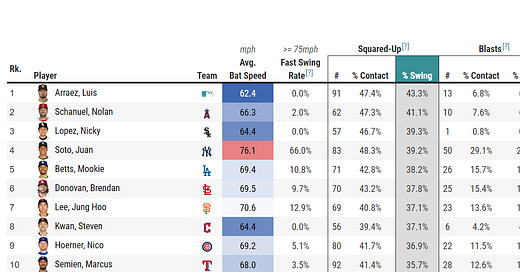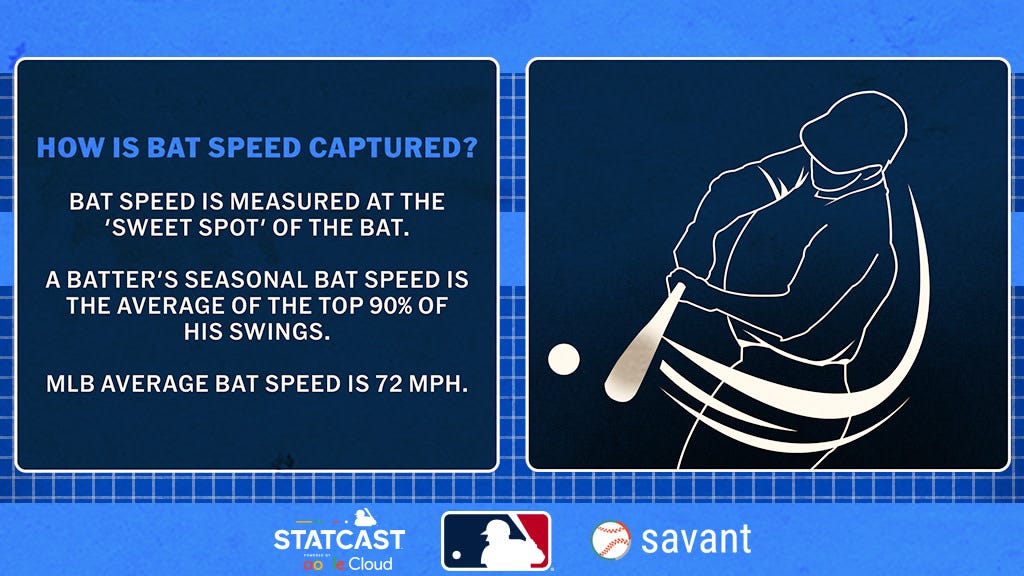Baseball Savant just released their new Bat Tracking metrics this week. This new dataset is full of excitement for metric lovers, and the unexpected release has only aided the hype. They outline underlying data like bat speed, fast swing rate, squared-up swings, blasts, swing left, swords, competitive swings, comp. Swings hit into play, and links to visuals for each player. I am not here to break down the Bat Tracking metrics and page, but more to ask a question. Should Bat Tracking metrics be incorporated into the xStats formulas (or something new)?
Admittedly, I am not the smartest statistician out there. I understand xStats and metrics, but do not consider myself a master by any means. So this could be a pretty stupid question, but hear me out. For starters, xStats have been found to lack a predictive quality and are mainly about contact quality of that year. The xStats are about the controllables for a hitter. Hit the ball hard and elevate it. An outfielder making a diving catch or robbing a home run is out of the hitter's control and, therefore, does not get reflected in their production. However, xStats recognize that the hitter should have a double or should have hit a home run even though they did not.
These new metrics now add another layer to what a player can control. The squared-up percentage calculates how much a hitter maximizes the possible exit velocity based on pitch speed and swing speed. Even if the pitch is slow, the bat speed is low, or a player genuinely lacks power, we can see if they are maximizing their exit velocity.
Many hitters who do not impact the ball/hit the ball hard will lack above-average metrics. There are naturally outlier bat-to-ball guys that post elite xBA numbers like Luis Arraez, Steven Kwan, and Nico Hoerner, all in 2023. These guys do not hit the ball very hard and do not have an average exit velocity, hard hit rate, or barrel rate above the 29th percentile. Again this was just for 2023, and these guys are elite hitters and outlier bat to ball magicians.
Another guy that made a resurgence in his early 30s as a bat to ball merchant was Donovan Solano. He was very similar to Brendan Donovan from a batted ball profile perspective. Since 2019, you will see Solano’s name at or near the top of leaderboards in both xBA and sweet spot percentage.
Without explicitly saying it, we have started to establish how important sweet spot percentage and launch angle (preferably in the 8-11 degree range) is for players that do not hit the ball very hard. Being a consistent line drive is imperative. This supports the controllable launch angle notion of xStats.
However, the xwOBAs of these players do not always show that they are plus hitters. Steven Kwan entering 2024, had not had an xwOBA above the 50th percentile. He is not alone, there are plenty of players that show poor xwOBA numbers. Nico Hoerner is another example. These are premier bat to ball players in MLB, the best players at making contact and doing the most with it. Hoerner has not had an xwOBA above the 32nd percentile in a qualifying season.
If this is what the data is showing for the best bat-to-ball players, how are the above-average, but not elite bat to bat-to-ball players going to find their value at the big league level? This is where my question comes in. Kwan and Hoerner are seeing much more success this year, but what about the guys a tier or two below them. The Will Brennans, Brice Turangs, Nolan Schanuels, heck, even the Nicky Lopez of the league. All four of these players and many more, I’m sure, are posting well above average squared-up percentages on both the percent of swings they make contact on and the percent of total swings they take.
There are players that are not being recognized as valuable because they do not have good control of the “controllables” (exit velocity & launch angle), yet they are getting more out of their swings (and limited power) than most players in MLB. I believe there is value to that, and it should be reflected somewhere in the stats we use or in a future/new stat that is all-encompassing for a hitter.
The short (and easy) answer is they need to hit more line drives or elevate their launch angle 2-3 degrees. Many of them do, all four of these players I pointed out as examples as second tier bat to ball hitters have lower line drive percentages from last year.
However, the game is evolving, and I am not one to put an end to this question. The industry is constantly looking for ways to evaluate players more thoroughly and effectively and this could be the next step. We must remember that the beautiful game we love is not just made up of numbers. Winning is the most important thing, putting the ball in play almost never ends with a worse result than striking out. Whether the player hitting the ball gets credited with the production or not, they are helping their team win games, and I do not think we have nailed that down in a quantified way yet.
Bat Tracking metrics have added such a nuanced layer to analytics, and I hope this article helps inspire your own original thoughts & questions as well. So please, let me know what you think! This is an invigorating time in baseball analytics and I know we will all be feasting on the latest information & interpretations that arise in the near future.






